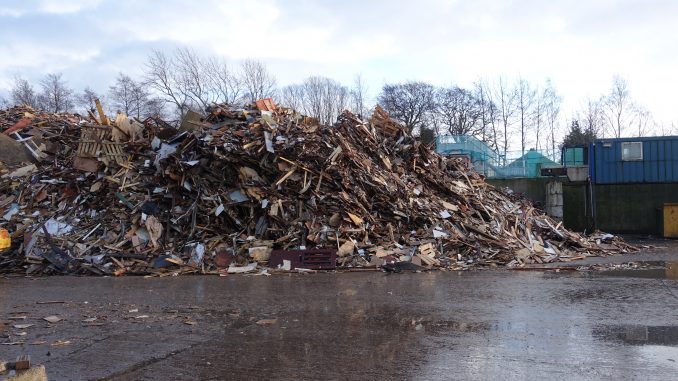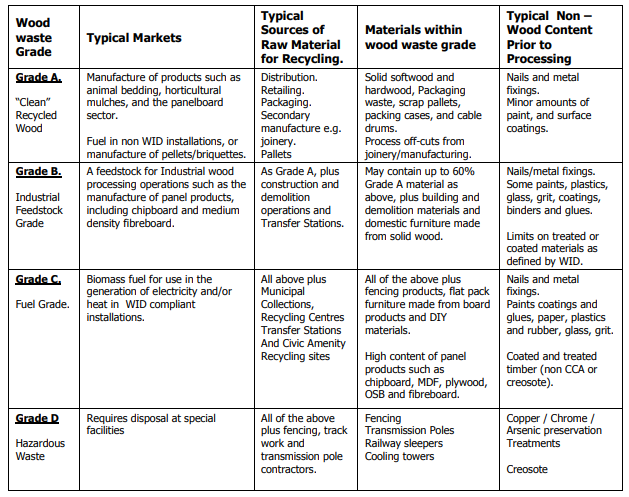
Waste wood in the UK seldom ends up as landfill. Instead, it is used for particle boards, animal bedding or biomass production. But waste wood originating from demolition, construction sites and municipal waste can be a mix of all sorts of wood elements like sawn timber, particle boards, MDF, pallets, laminates and more. This material needs to be sorted to allow a (cost-) efficient recycling or disposal. In the UK, the Wood Recycling Association (WRA) introduced a sorting system for wood waste (see below, from[1]). This system can be used, but is not mandatory.

It is needless to say that these grades have nothing to do with any strength grading system – that is not what they are for. They are not designed to allow a reuse of the timber in its original purpose, because they don’t take the size into account or try to estimate strength properties. But they allow sorting waste wood (basically just by its cleanliness) for use in the most common applications for recycled wood. In the UK these are particle boards (50%), biomass energy (25%) and animal bedding (17%)[2]. For all of these applications the original structure and strength of the timber elements is irrelevant because it is chipped into smaller particles.
How are these grades used in practice?
The companies who produce the wood waste are encouraged to sort it to reduce costs for the disposal (the costs will rise from grade A to grade D). Grade D timber is contaminated with hazardous materials (heavy metals, arsenic etc.) and needs to be incinerated in special facilities (by law). This is costly for the companies that are responsible for the disposal of the waste wood, so they will be likely to ensure as little as possible waste is classified as hazardous. Identifying treated timber is not easy though, since chemicals on the wood surface are not visible. The WRA is currently testing which timber members usually contain hazardous chemicals and these data could be used to sort out grade D timber. However, it seems they are not receiving enough samples to establish a reliable database which could mean that nearly all waste wood will need to be tested before recycling or disposal in the future (from end of July 2020, see this WRA Article).
For all other grades (grade A, B and C) the price difference for disposal might not be a sufficient incentive for the companies to sort their wood waste though. Often recycling plants will receive a mix of all grades they accept. For manufacturers of particle boards and energy producers this is an advantage. They will pay a lower price for the material and for the production all material is used collectively anyway. This means if a biomass energy producer receives a batch of grade C waste it doesn’t matter if in reality it contains 30% grade A, 50% grade B and only 20% grade C. The whole batch will be chipped, cleared from non-wood materials and burned. Many companies will use their own system to classify the material they receive (see the example of Timberpak here) with the only similarity being that hazardous waste is usually not accepted.
Could the system focus more on resource efficiency instead of only cost efficiency?
To avoid the waste of reusable wood (at least to some extend), the UK has established the Packaging recovery note (PRN) scheme. Companies who recycle packaging material receive PRNs for every ton of recycled material. Companies who use packaging have to buy these notes from the recycling company to comply with the Producer Responsibility Obligations. This scheme helps to make waste from pallets and other wooden packaging materials more valuable for recycling companies and makes their repair and recovery more likely.
On the other hand, the UK government supports the generation of electric and heat energy from biomass, which encourages (financially) a quick energetic use. Decent recovered wood and even virgin timber is burnt in energy plants instead of being used in long-life products. This also distorts markets and producers of particle boards and other products from recovered wood are voicing their concern when they see the government supporting the energy sector. This, unintentionally, encourages a wasteful use of recovered and virgin timber alike and impairs its use in products due to increased material prices. Especially established businesses struggle with the lack of support for their efforts to enhance circularity in their production.
Smaller businesses on the other hand can get some funding from the government or organisations like Zero Waste Scotland. Community wood recycling companies like Glasgow Wood Recycling or Move On Wood Recycling are using grade A, B and C wood waste. These initiatives manufacture high value products like unique furniture and ornaments. But they also prove that not all wood should be chipped after its first use and that a company based on environmental and social values can be a viable concept. Of course, the most valuable wooden elements of buildings have long been recovered as architectural salvage – but what’s missing is the middle ground – between the chips and the salvage market.
Our own efforts in the InFutUReWood project are focused on the reuse of timber in construction. Apparently the circular use of timber is mainly inhibited by the lack of engagement with the construction and demolition sector when it comes to changing current practices to more sustainable ones ([3] and our observations when interviewing recycling companies in the UK).
[1] M. Greenhalf and M. Brown, “ The Business Case for Wood Waste Collection Hubs”
[3] J. Hart, K. Adams, J. Giesekam, D. D. Tingley, and F. Pomponi, “Barriers and drivers in a circular economy: the case of the built environment”

I think governments need to stop subsidizing incineration and use that money instead to create good recycling streams. Or also as huge benefit to our increasing CO2 atmospheric levels would be to use the Wood / biomass to create BioChar.